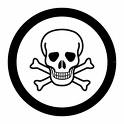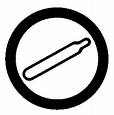Chem 11 Safety Quiz

Dr. Charles Best Science
Chemistry 11 safety quiz
- 1.
When you want to check the odour of a chemical, you should:
- A.
Leave the open container near you and wait for the odour to reach you
- B.
Blow the air towards you with a fan
- C.
Gently wave the air towards you with your hand
- D.
Sniff directly over the container
Correct Answer
C. Gently wave the air towards you with your handExplanation
To check the odor of a chemical, it is recommended to gently wave the air towards you with your hand. This method allows for a controlled and gradual exposure to the odor, preventing any strong or potentially harmful fumes from directly reaching the nose. By waving the air towards you, it helps to disperse the odor and allows you to get a sense of the smell without overwhelming your senses. Sniffing directly over the container or blowing the air towards you with a fan can result in a sudden and concentrated exposure to the odor, which may be unpleasant or even dangerous.Rate this question:
-
- 2.
Acid is splashed into someone's eye. What should be done immediately?
- A.
Apply a bandage with antiseptic cream to the area
- B.
Keep the eyelid closed and call for a doctor
- C.
Spray or pour water on the eye
- D.
Put baking soda on the area around the eye
Correct Answer
C. Spray or pour water on the eyeExplanation
When acid is splashed into someone's eye, the immediate action should be to spray or pour water on the eye. This is because water helps to dilute and rinse out the acid, minimizing its harmful effects on the eye. It is important to flush the eye with water for at least 15 minutes to ensure thorough rinsing. Keeping the eyelid closed and calling for a doctor is also recommended, as medical attention may be necessary to assess and treat any potential damage caused by the acid. Applying a bandage with antiseptic cream or putting baking soda on the area around the eye is not appropriate in this situation.Rate this question:
-
- 3.
When heating a liquid in a test tube over the Bunsen burner flame, which of the following should not be done?
- A.
Continue to gently move the test tube while heating
- B.
Use a test tube holder
- C.
Cover the open end of the test tube with paper towel
- D.
Ensure that the open end of the test tube is not pointing at anyone
Correct Answer
C. Cover the open end of the test tube with paper towelExplanation
Covering the open end of the test tube with a paper towel should not be done when heating a liquid in a test tube over the Bunsen burner flame. This is because the paper towel can easily catch fire and cause a hazardous situation. It is important to use a test tube holder to hold the test tube securely while heating, gently move the test tube to ensure even heating, and ensure that the open end of the test tube is not pointing at anyone to prevent any potential accidents or injuries.Rate this question:
-
- 4.
When you have finished a lab, how should you dispose of the chemicals you were using?
- A.
Down the sink with a lot of water after checking with the teacher
- B.
In a special container provided by the teacher
- C.
The procedure varies depending on what is most convenient at the time
- D.
Both A) and B) with the teachers advice
Correct Answer
D. Both A) and B) with the teachers adviceExplanation
When you have finished a lab, you should dispose of the chemicals you were using by either pouring them down the sink with a lot of water after checking with the teacher or by placing them in a special container provided by the teacher. The appropriate method of disposal may vary depending on the specific chemicals used and the instructions given by the teacher. It is important to seek the teacher's advice to ensure proper and safe disposal of the chemicals.Rate this question:
-
- 5.
If your clothing catches fire, what should you not do?
- A.
Roll about on the floor in order to smother the flames
- B.
Yell immediately for help
- C.
Run quickly for help
- D.
Get under and turn on the safety shower
Correct Answer
C. Run quickly for helpExplanation
If your clothing catches fire, running quickly for help is not the recommended action. This is because running can fan the flames and cause the fire to spread more rapidly. Instead, it is important to remember the "Stop, Drop, and Roll" technique, which involves dropping to the ground, covering your face, and rolling back and forth to smother the flames. Yelling immediately for help is also a good idea to alert others nearby. Getting under and turning on the safety shower is not applicable in this situation, as safety showers are typically used for chemical spills or exposure rather than fire emergencies.Rate this question:
-
- 6.
What is the recommended way to find out whether an object is hot or cold?
- A.
Wet your finger and touch the object
- B.
Spit on the object
- C.
Bring the back of your hand close to the object
- D.
Bring the palm of your hand close to the object
Correct Answer
C. Bring the back of your hand close to the objectExplanation
The recommended way to find out whether an object is hot or cold is by bringing the back of your hand close to the object. This method is recommended because the back of the hand is more sensitive to temperature than the palm. By using the back of the hand, you can better gauge the temperature of the object without the risk of burning yourself or getting a false reading.Rate this question:
-
- 7.
Which of the following precautions should you take while doing an experiment in the science lab if you wear contact lenses?
- A.
Be aware that some fumes can affect the materials of contact lenses
- B.
Always wear eye protection such as safety goggles or a face shield
- C.
Never adjust the contact in the science room
- D.
All of the above
Correct Answer
D. All of the aboveExplanation
While doing an experiment in the science lab, it is important to take certain precautions if you wear contact lenses. Firstly, you should be aware that some fumes can affect the materials of contact lenses, so it is necessary to be cautious about the chemicals and fumes present in the lab. Secondly, always wear eye protection such as safety goggles or a face shield to protect your eyes from any potential hazards. Lastly, it is advisable to never adjust the contact lenses in the science room as it may lead to contamination or damage. Therefore, all of the above precautions should be taken while doing an experiment in the science lab if you wear contact lenses.Rate this question:
-
- 8.
It is correct procedure to add excess chemicals to the original stock bottle.
- A.
True
- B.
False
Correct Answer
B. FalseExplanation
Adding excess chemicals to the original stock bottle is not the correct procedure. This can lead to contamination of the entire stock and may result in inaccurate measurements and experimental errors. It is important to add the required amount of chemicals to maintain the integrity and accuracy of the stock solution.Rate this question:
-
- 9.
Safety goggles are only worn when you are actually handling chemicals
- A.
True
- B.
False
Correct Answer
B. FalseExplanation
Safety goggles are not only worn when you are actually handling chemicals. They are worn in any situation where there is a risk of eye injury, such as when working with tools, machinery, or in environments where there are flying objects or particles. Safety goggles provide protection from various hazards, not just chemicals. Therefore, the statement is false.Rate this question:
-
- 10.
Use the following MDSD link to find the melting point temperature of KCl (potassium chloride)
- A.
658 deg. C
- B.
772 deg. C
- C.
129 deg. C
- D.
900 deg. C
Correct Answer
B. 772 deg. CExplanation
The correct answer is 772 deg. C. This is the melting point temperature of KCl (potassium chloride) according to the provided MDSD link.Rate this question:
-
- 11.
What is the correct description for this WHMIS symbol?
- A.
Corrosive material
- B.
Dangerously reactive material
- C.
Poisonous and infectious material
- D.
Materials causing other toxic effects
Correct Answer
C. Poisonous and infectious materialExplanation
The correct description for this WHMIS symbol is "Poisonous and infectious material." This symbol is used to indicate substances that are toxic and can cause harm if ingested, inhaled, or come into contact with the skin. These materials may also have the potential to spread infectious diseases. It is important to handle and store these substances with caution to prevent any harm or contamination.Rate this question:
-
- 12.
What is the correct description for this WHMIS symbol?
- A.
Flammable and combustible material
- B.
Corrosive material
- C.
Compressed gas
- D.
Dangerously reactive material
Correct Answer
C. Compressed gasExplanation
The correct description for the WHMIS symbol is "Compressed gas." This symbol is used to indicate substances that are stored under high pressure and can explode or cause damage if mishandled. These materials are typically contained in cylinders and can pose a risk if they are not handled properly.Rate this question:
-
- 13.
Use the following MDSD link to find the First Aid Measures for accidental ingestion of chromium oxide.
Quiz Review Timeline +
Our quizzes are rigorously reviewed, monitored and continuously updated by our expert board to maintain accuracy, relevance, and timeliness.
-
Current Version
-
Aug 19, 2023Quiz Edited by
ProProfs Editorial Team -
Feb 06, 2009Quiz Created by
Wchoi
- Aeronautics Quizzes
- Aerospace Quizzes
- Agricultural Science Quizzes
- Astrology Quizzes
- Astronomy Quizzes
- Atom Quizzes
- Biochemistry Quizzes
- Biology Quizzes
- Biomechanics Quizzes
- Biostatistics Quizzes
- Biotechnology Quizzes
- Botany Quizzes
- Branches Of Science Quizzes
- Cytology Quizzes
- Easy Science Quizzes
- Ecology Quizzes
- Electrical Quizzes
- Embryology Quizzes
- Endocrinology Quizzes
- Engineering Quizzes
- Environmental Science Quizzes
- Epidemiology Quizzes
- Experiment Quizzes
- Forestry Quizzes
- Fossil Quizzes
- Gas Quizzes
- General Science Quizzes
- Genetics Quizzes
- Histology Quizzes
- Human Biology Quizzes
- Integrated Science Quizzes
- Invention Quizzes
- Library Science Quizzes
- Lighting Quizzes
- Liquid Quizzes
- Marine Biology Quizzes
- Microbiology Quizzes
- Molecular Biology Quizzes
- Nature Quizzes
- Neuroscience Quizzes
- Nuclear Science Quizzes
- Oceanography Quizzes
- Physics Quizzes
- Psychology Quizzes
- Science And Technology Quizzes
- Science Glossary Quizzes
- Science Knowledge Quizzes
- Science Practice Quizzes
- Scientific Method Quizzes
- Scientific Notation Quizzes
- Soil Science Quizzes
- Solar System Quizzes
- Solid Quizzes
- Zoology Quizzes
 Back to top
Back to top




